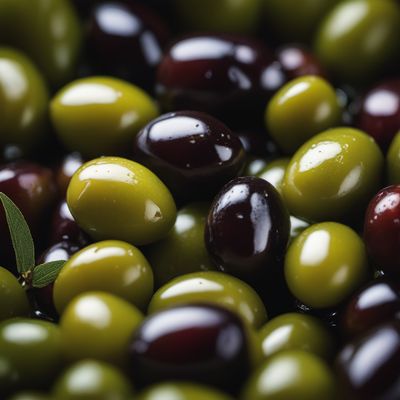
Ingredient
Oil fruits
The Golden Bounty: Unveiling the World of Oil Fruits
Oil fruits encompass a wide range of fruits that are known for their high oil content. These fruits are typically fleshy and contain a seed or pit that is rich in oil. They come in various shapes, sizes, and colors, with some having a smooth skin while others have a rough or textured exterior. The flesh of oil fruits can range from soft and juicy to firm and fibrous. The oil extracted from these fruits is often used in cooking, baking, salad dressings, and as a base for various cosmetic and skincare products. The taste of oil fruits can vary greatly, with some being sweet and buttery, while others have a more nutty or earthy flavor. The texture of the flesh can also differ, ranging from creamy and smooth to slightly grainy or fibrous. The appearance of oil fruits can be vibrant and colorful, with hues of green, yellow, orange, or red, depending on the specific fruit.
Origins and history
Oil fruits have a rich history that dates back thousands of years. Many of these fruits have been cultivated and used for their oil since ancient times. Olives, for example, have been cultivated in the Mediterranean region for over 6,000 years and have played a significant role in the culinary traditions of countries like Greece, Italy, and Spain. Avocados, native to Central and South America, have been consumed for thousands of years by indigenous cultures. Other oil fruits, such as coconuts, palm fruits, and various nuts, have been used for their oil in different parts of the world for centuries. These fruits have not only provided a valuable source of nutrition but have also been used for medicinal and cosmetic purposes throughout history.
Nutritional information
Oil fruits are packed with essential nutrients and healthy fats. They are a good source of monounsaturated and polyunsaturated fats, which are beneficial for heart health. These fruits also contain vitamins, minerals, and antioxidants that support overall well-being. While the nutritional composition varies among different oil fruits, they generally provide a good amount of fiber, vitamins E and K, potassium, and magnesium. It is important to note that oil fruits are high in calories due to their fat content, so portion control is key.
How to select
When selecting oil fruits, look for fruits that are firm, plump, and free from any bruises or blemishes. The skin should be smooth and vibrant in color. For fruits like avocados, gently squeeze the fruit to check for ripeness - it should yield slightly to pressure without being too soft. For olives, choose fruits that are evenly colored and have a firm texture. When purchasing oil fruits from a farmers market, ask the vendor for recommendations on the best varieties and inquire about the fruit's freshness.
Storage recommendations
Oil fruits have different storage requirements depending on their ripeness and the specific fruit. Avocados, for example, can be stored at room temperature until they are ripe, and then refrigerated to slow down the ripening process. Olives can be stored in a brine solution or olive oil to preserve their freshness. Nuts, such as almonds or walnuts, should be stored in a cool, dry place to prevent them from going rancid. It is important to follow the specific storage recommendations for each oil fruit to maintain their freshness and quality.
How to produce
Growing oil fruits can be a rewarding experience for amateur gardeners. Depending on the specific fruit, oil fruits can be grown from seeds, seedlings, or young plants. Research the specific requirements for each fruit, including soil type, sunlight, and watering needs. Some oil fruits, like avocados and olives, require a warm climate and well-drained soil, while others, like coconuts, thrive in tropical regions. Consider the space available and the climate of your area before deciding which oil fruit to grow.
Preparation tips
Oil fruits can be used in a variety of ways in the kitchen. Avocados can be mashed and spread on toast, used as a base for creamy sauces or dressings, or added to smoothies for a nutritious boost. Olives can be enjoyed as a snack, used in salads, or incorporated into Mediterranean dishes like pasta or pizza. Coconuts can be used for their flesh, milk, or oil in both sweet and savory recipes, such as curries, desserts, or smoothies. Nuts, like almonds or walnuts, can be eaten as a snack, used in baking, or ground into nut butter. When using oil fruits in cooking, it is important to consider their flavor and texture to ensure they complement the other ingredients in the dish.
Culinary uses
Oil fruits are widely used in various cuisines around the world. Olives are a staple in Mediterranean cooking, used in dishes like Greek salads, tapenades, and pasta sauces. Avocados are popular in Mexican cuisine, where they are used to make guacamole, added to tacos, or used as a topping for soups and salads. Coconuts are commonly used in Southeast Asian and Caribbean cuisines, where they are used in curries, desserts, and refreshing beverages. Nuts, such as almonds and walnuts, are versatile ingredients that can be used in both sweet and savory dishes, including baked goods, salads, and stir-fries.
Availability
Oil fruits are commonly available in regions where they are cultivated. Olives are widely cultivated in Mediterranean countries like Spain, Italy, and Greece. Avocados are grown in countries like Mexico, the United States, and Peru. Coconuts are abundant in tropical regions such as Southeast Asia, the Caribbean, and parts of Africa. Nuts, like almonds and walnuts, are grown in various countries around the world, including the United States, Spain, and Australia.
More ingredients from this category

Oil palms fruits and similar-
The Golden Harvest: Unlocking the Secrets of Oil Palm Fruits

Kapok and similar-
The Versatile Plant Fiber

Olives for oil production and similar-
Liquid Gold: The Versatile Olives

Other oil fruits
The Versatile Oil Fruits

Oil palms kernels and similar-
The Golden Gems of the Tropics